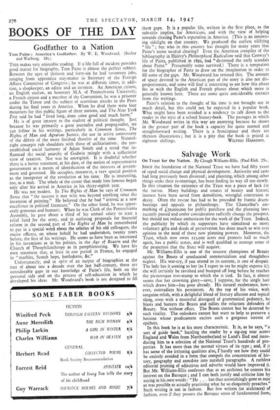Salvage Work
On Trust for the Nation. By Clough Williams-Ellis. (Paul Elek. 25s.
SINCE the foundation of the National Trust we have had fifty years of rapid social change and physical development. Authority and taste had long previously been divorced; and planning, which among other things seeks their re-marriage, has been finding its way all too slowly. In this situation the existence of the Trust was a piece of luck for the nation. Many buildings and estates of beauty and historic interest have been saved from demolition, wrongful conversion or decay. Often the rescue has had to be preceded by frantic drum- beatings and appeals to philanthropy. The Chancellor's ear- marking of £5o,000,000 for public purchase and the planning laws recently passed and under consideration radically change the prospect, but should not reduce enthusiasm for the work of the Trust. Indeed, the publicity by which its supporters have stimulated so many voluntary gifts and deeds of preservation has done much to win civet opinion to the need of these new planning powers. Moreover, the Trust, which now owns 115,000 acres and protects half as much again, has a public status, and is well qualified to manage some of the properties that the State will acquire.
Mr. Williams-Ellis is one of the stoutest champions of Beauty against the Beasts of uneducated commercialism and thoughtless neglect. His war-cry, if you attend to its content, is one of despair. The lady has it coming to her (as I regret to say he might express it); she will certainly be ravished and bumped off long before he reaches the picturesque tree-stump to which she is tied. In fact, it almost seems that her crowning glory—save, I suppose, for the single hair which draws him—has gone already. His natural exuberance, how- ever, contradicts his pessimism. At the top of his voice, with sanguine relish, with a delightful blend of literary allusion and topical slang, even with a masterful disregard of grammatical pedantry, he blasts and banters the Beasts and rallies the reluctant defenders of Beauty. Not without effect. The Beasts cannot but be deterred by such vitality. The onlookers cannot but want to help to preserve a heroine whose predicament excites such a gorgeous torrent of epithets.
In this book he is at his most characteristic. It is, as he says, "a sort of guide book," hustling the reader by a zig-zag tour across England and Wales from Northumberland to Land's End and intro- ducing him to a selection of the National Trust's hundreds of pro- perties. It has more than the normal virtues of its type' and, if it has some of the irritating qualities also, I' hardly see how they could be entirely avoided in a form that compels the concentration of his- tory, geography and anecdote into nutshell paragraphs. A ruthless editorial pruning of adjectives and adverbs would have improved it. But Mr. Williams-Ellis confesses that as an architect he centres his interest on the Baroque ; and I can both justify and criticise him by saying in his own words : "He . . . has thus astonishingly gone as near as was possible to actually practising what he so eloquently preaches." Such writing is not in fashion. But few writers (or architects) of fashion, even if they possess the Baroque sense of fundamental form,
have the Baroque inventiveness and wit in which Mr. Williams-Ellis is rich. The gusto of his appreciation takes hold of the reader, who longs to test his own reactions to the buildings and scenes described. And many happy phrases remain in the mind for recurring enjoy- ment.
Some drawings by Barbara Jones, and many photographs, illumi- nate the text. But the general presentation of the book leaves some- thing to be desired. The limn of print are rather long for the size and spacing of the type ; the thin art-paper tends to wrinkle and buckle, and the maps at the end are reminiscent of a railway guide. Times are difficult, we know, but in a book dedicated to Beauty we look for



































 Previous page
Previous page